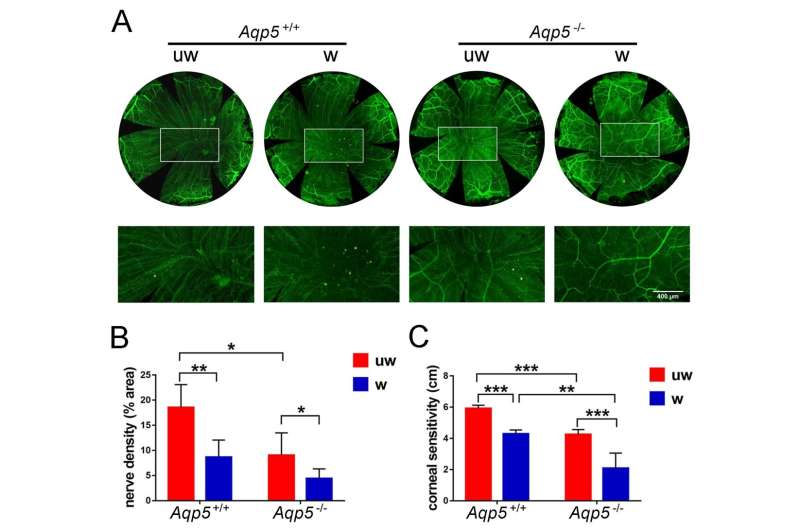New study suggests that aquaporin could be key to repairing corneal defects


Corneal defects often heal themselves, but serious injuries that are left untreated can result in inflammation, infection, ulceration and even blindness. A new study provides exciting evidence supporting the involvement of aquaporins in corneal cell proliferation and nerve regeneration and suggests aquaporin 5 (AQP5) induction as a potential therapy to accelerate the resurfacing of corneal defects, report scientists in The American Journal of Pathology.
The cornea, which consists of transparent tissue in the outermost layer of the eye, acts as a barrier against external stimuli. It also plays a key role in vision.
“As a member of aquaporin family, AQP5 is expressed in cornea, which is related to many eye diseases,” explained lead investigator Peng Chen, Ph.D., Department of Human Anatomy, Histology and Embryology, School of Basic Medicine, Qingdao University, Shandong Province; and Institute of Stem Cell Regeneration Medicine, School of Basic Medicine, Qingdao University, Qingdao, China. “If a corneal injury cannot heal in time, it may lead to pathogen invasion and result in corneal inflammation, turbidity, ulcer and even blindness. In previous studies, we found that AQP5 deficiency can cause corneal epithelial punctate defects. There is also increasing evidence that nerve growth factor (NGF) plays a key role in corneal wound healing. AQP5 deficiency can slow down the repair of corneal epithelial injury in mice, but its specific mechanism remained unclear. We hypothesized that AQP5 plays an important role in one or more stages of corneal epithelial regeneration and explored the specific mechanism of AQP5.”
Investigators generated an Aqp5 knockout (Aqp5-/-) mouse model and performed corneal wound healing on corneas from which epithelial cells had been scraped away. They used 75 male Aqp5 +/+ mice and 189 male Aqp5-/- mice aged 10 to 12 weeks. Time to corneal epithelial and nerve regeneration was significantly delayed in the Aqp5-/- mice. To determine the role of NGF in the repair of corneal epithelial injury, NGF was injected in the subconjunctival space after corneal epithelium was scraped off in Aqp5-/- mice. The epithelial and nerve regeneration rate were significantly promoted in Aqp5-/- mice with the treatment of NGF, which also improved the recovery of corneal nerve fiber density and sensitivity in Aqp5-/- mice, accompanied by recovered levels of phosphorylated Akt.
The investigators also administered an Akt inhibitor in addition to NGF in Aqp5-/- mice to determine the mechanism of NGF regulating the repair rate of corneal epithelial injury. However, the promotion of NGF induced corneal epithelial and nerve regeneration rate and Akt reactivation was reversed by the Akt inhibitor.
“It is exciting to find that Aqp5 deficiency can affect the nerve regeneration of mice by affecting the activation of NGF and Akt signaling pathways, which is not found in previous studies,” commented Dr. Chen. “These results need to be confirmed in a clinical setting, but they provide evidence for the involvement of aquaporins in cell proliferation and nerve regeneration and suggest AQP5 induction as a possible therapy to accelerate the resurfacing of corneal defects.”
Source: Read Full Article




